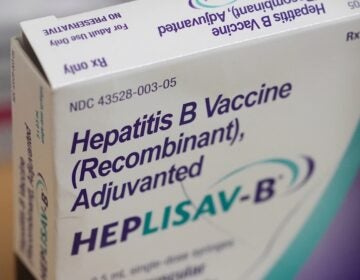Fake patient, real threat: UPMC prepares for worst case scenario
To prepare for the possibility of Ebola or another deadly disease, hospitals practice protocols created to keep staff and patients safe.
Listen 3:43
EMTs unload Parag S. Gohel from an ambulance at UPMC Presbyterian's ER. Gohel is in an isolation pod because he’s pretending to have an infectious disease for the hospital’s yearly drill. (Sarah Boden/WESA)
An ambulance pulled up to the entrance of UPMC Presbyterian’s emergency room in early June, a pair of EMTs unloaded a portable isolation pod, basically a human-sized, medical-grade Ziploc bag.
Inside the pod was a professional actor named Parag S. Gohel. Gohel wasn’t really sick but did a convincing job of looking sweaty and uncomfortable.
All other ambulances were diverted while Gohel pretended to be infected with some sort of highly contagious disease. It was part of a drill that included EMTs, law enforcement and UPMC medical staff.
This is the third year UPMC has held this drill. During the last Ebola epidemic, which took place from 2014 to 2016, more than 11,000 people died, including two in the U.S. This year, 27 people have perished in the Democratic Republic of Congo from an Ebola outbreak that began in April.
To prepare for the possibility of Ebola or another deadly disease, hospitals practice protocols created to keep staff and patients safe.
Before wheeling Gohel inside, two nurses wearing what look like poorly fitting spacesuits cleaned the outside of the pod with disposable bleach wipes.
“They’re trying to use it as another kind of infection control measure. That’s another barrier sort to speak,” said Dr. Gavin Harris, who is in the second year of a dual fellowship in critical care and infectious disease.
Harris said he didn’t know disinfecting the outside of the pod would actually make a difference.
“We’re kind of doing everything we can,” he said. “Our hope is that any sort of little thing we can do might be able to help.”
The nurses transported Gohel into a room with a special ventilation system that filters the air and funnels it directly outside. They helped him out of the isolation pod, made sure he lying comfortably and then took some vital signs and blood samples – routine tasks made more difficult by the bulky, awkward suits they wore.
“I think they’ve done a great job,” said Harris. “Especially adapting because one of the earpieces came out earlier, so they had to resort to hand signals and lip reading … which is great [simulation] for real word exercises.”
Drill monitors checked off each safety protocol and everything seemed to be going well. But Gohel’s wasn’t out of the woods yet.
He was handed a cup of fake vomit, made with a crumbled bagel, Pepsi, lemonade and cranberry juice, which gave it a reddish hue. Then he tossed this mixture onto the floor while retching.
The nurses sprang into action to clean it up. Red vomit indicates possible internal bleeding.
“Blood of a patient with Ebola contains 10 million virus particles in every milliliter of blood. It’s very, highly infectious,” said Bill Pasculle, director of UPMC’s clinical microbiology laboratories. “[Compared to the flu] that’s 1,000 times more.”
The fake patient, fake vomit and fake diagnostic tests might all seem over the top, but Jackie Stange, a staff nurse who was doing this training for the second time, said practice is important in case someone with a serious disease like Ebola ever comes to UPMC for treatment.
“I feel much more confidence in knowing what to do if something like this were to occur,” she said. “Then not being trained and God forbid something like this did happen in Pittsburgh.”
90.5 WESA’s Bridges to Health covers the well-being of Pennsylvanians and is funded by the Jewish Healthcare Foundation. WESA receives funding from the University of Pittsburgh and UPMC.
WHYY is your source for fact-based, in-depth journalism and information. As a nonprofit organization, we rely on financial support from readers like you. Please give today.




